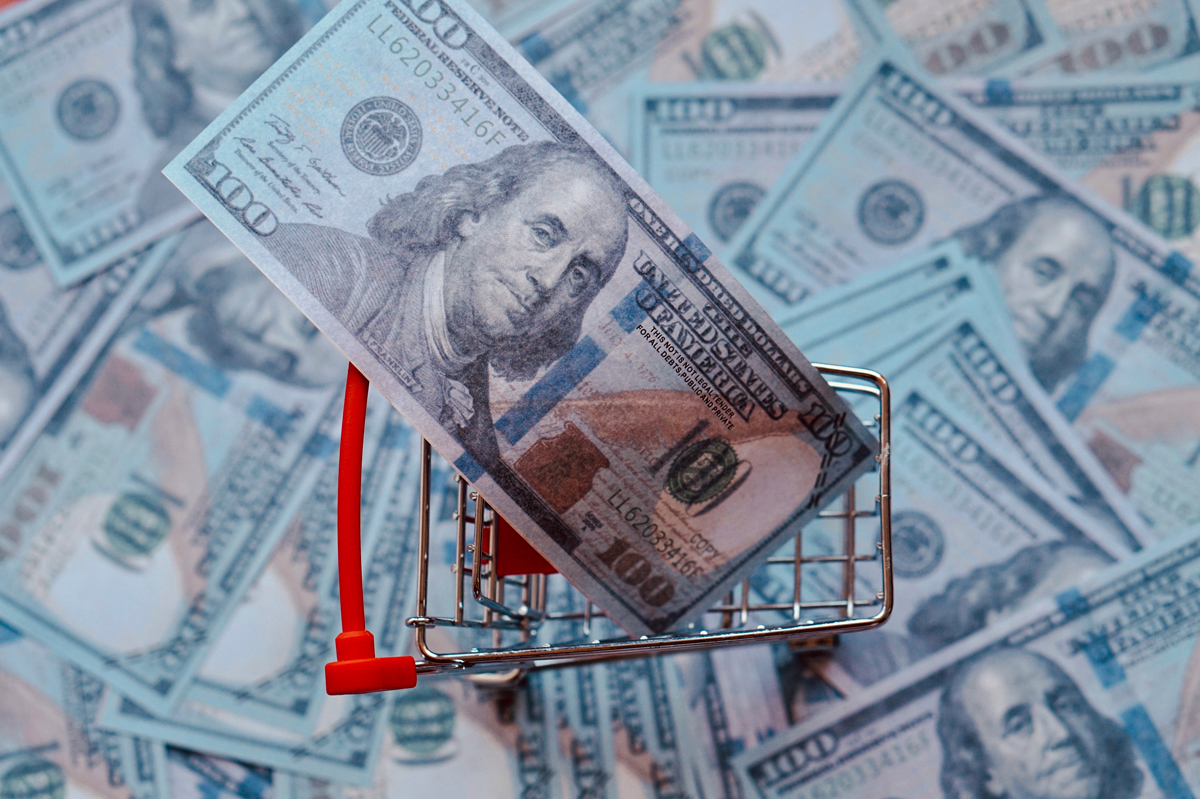Have you ever thought of beginning an online business on Amazon? Maybe you didn’t even know that it is even possible to sell products on Amazon.
You might be looking for a side hustle or maybe even someday quit the J.O.B.
If so, you are going to want to read below. I have a business that might be right up your alley and it’s called:
Retail Arbitrage
I remember the first time I heard about the idea of retail arbitrage. I thought it was insane. That was 10 years ago and I have been selling on Amazon ever since.
Retail arbitrage is a method that you can use to sell products on Amazon FBA or other marketplaces that you may find at your local stores.
After reading this guide, you will never walk into another store without discovering something you can possibly sell for a profit.
In this guide, we will talk about retail arbitrage on Amazon and what it involves.
What is Retail Arbitrage on Amazon?
Retail arbitrage on Amazon in simple terms refers to a business venture where a seller purchases items from nearby retail stores at reduced price and resells those items on Amazon FBA for at a higher price for a profit.
For instance, you may visit a retail store like Walmart and discover an item selling for $25 on Amazon can be purchased for $5.
You purchase them for $5, send it into Amazon and sell the item for $25. Your profit is $25 – $5 – Amazon Fees & Shipping costs.
Aka – you make money finding deals and selling them to other people around the country. They are happy and you make money.
Multiple that by the number of the same items you find at each store and you get the picture of how lucrative this could be.
Truth be told, that you don’t always find extremely profitable items, but it still averages out to a healthy profit if done correctly.
You might be thinking if this is too good to be true. I’m right there with you. That being said, there are some economic principles that actually make this legit and a profit business.
If you understand the principles, you will understand how you can utilize the market to make some money.

Can You Make Money With Retail Arbitrage?
Well. If you couldn’t, I wouldn’t be writing this post.
Heck yes you can make some money. But it takes some knowledge and skill to make it happen.
You can make good money from retail arbitrage when you purchase products at a fairly lower cost than the returns you will get from the item when you sell it on a marketplace like Amazon (considering the fees & Amazon’s cut).
Let’s give an example:
You purchased a toy from a neighborhood retail store for $10 and it is selling for $24.99 on Amazon.
Amazon deducts FBA fee and fulfillment expenses and pays you $18 after a buyer purchases your product.
You have profited $8 on that toy after the fees and your cost of goods sold (COGS).
Again – this sounds a lot like a get rich scam. Why would anyone buy something that costs more online than in a store?
It’s simple: Economics
- Convenience – People don’t want to shop around. They don’t have the time or desire to run to every store in town to find the lowest price. They are shopping on Amazon to have it delivered to their door. They are willing to spend more to have the convenience.
- Lack of information – People are inherently lazy, so they won’t do the research. That being said, they honestly don’t know that the Walmart on 9th Street has an item on sale that is full price at the Kroger on 15th Street. That’s too much searching and people don’t have the time.
Retail arbitrage works because people don’t know there are better deals in a retail store. And they don’t have the time to figure it out.
By speculating and finding these items to sell, you are fulfilling a market need to help balance the supply and demand curves.
Why Would Someone Buy on Amazon and Not Cheaper Elsewhere?
After reading the basics, I imagine you are still wondering why anyone in their right mind would spend more online than in a store.
You are going: Economics is a fancy answer, but that doesn’t tell me crap.
So let’s go a little further into the depths of human behavior. These points are all in addition to the paragraphs above:
Different Kind of Buyers
A few buyers are accustomed to looking around for the best price for items, while many others wouldn’t bother looking for better prices around before they make purchases.
Many people often see prices of products on Amazon as the general standard and many customers can’t even know that you bought the enlisted items at discounted rates somewhere.
It’s not that they aren’t price aware, but they just don’t have information to know there is a price difference.
Product Availability
Sometimes, consumers may find it difficult to find a specific item or product in nearby stores.
Even bigger stores like Walmart run of stock for some items quickly.
When a product turns out to be hard to find (think of a hot toy), the price shoots up because of high demand.
Likewise, an individual may move to a new area and realize that they can’t get a certain item at all stores around his new area.
In such a scenario, the most convenient option is to visit Amazon and get the item instead of scouring your local area for it. Such a person wouldn’t mind the cost of the item even if it cost more on Amazon than local stores in the former location.
What matters most to some consumers is the availability or accessibility of what they want to buy and not the price variability.
Amazon is consistently in stock of a large variety of products making Amazon a preferred choice for shopping.
However, the same items don’t have the same cost everywhere. The rate of demand for some products varies with location. This varying level of demand would determine the price of the item. It is pure and simple economics at its core. It is what drives arbitrage to its given possibilities.
Sellers on Amazon can take advantage of this variability in demand and cost of an item in different locations to make good sales and profit.
Other Reasons
Amazon is actually where a majority of users start their search for things. This means that they will usually just purchase what they find and not even hunt around for a better deal.
Amazon often has a wide variety of products available, and the online marketplace hardly runs out of stock of popular items.
Buyers can easily use filters to search for any item. These are reasons why many people consistently consider Amazon as their go-to place for shopping.
Is Retail Arbitrage Permitted on Amazon?
Amazon has consistently permitted retail arbitrage and will continue to be a leading platform for retail arbitrage. Sellers are allowed to enlist items they have purchased from commercial centers and resell them on Amazon.
Simply put: It is allowed and there is money to make if you do it.
Retail Arbitrage on Amazon
Now that you have realized how gainful retail arbitrage on Amazon can be, you need to know how to go about it. It’s actually pretty easy.
Create an Amazon Seller Account
The initial step to getting started as an Amazon seller is to open an Amazon seller account.
There are two types of accounts available: the individual seller account or a professional seller account.
Individual Seller Account
This account is free to create, but you will be charged a $0.99 fee per item sale on Amazon.
You are also required to pay a 15% consolidated fee on your sales.
The individual seller account is only meant for sellers who have not more than 40 products up for sale.
This Amazon account type is intended for sellers with limited quantities of products to sell and sellers who do not intend to sell items from restricted categories.
Professional Seller Account
In this account type, you pay a monthly fee of $39.99. Other extra charges incorporated are the referral fees and variable closing fees.
In this account type, Amazon doesn’t charge fees per item sold, and you can sell items without incurring the $0.99 fee per item.
A professional account is also necessary if you need access to the API & other advanced reporting features.
Meanwhile, you are also required to choose between two fulfillment options: Fulfillment by Amazon method (FBA) and the fulfillment by merchant (FBM).
If you are an Amazon FBA seller, you would have to send your inventory to different warehouses across the country and Amazon handles the fulfillment to the customer for you.
Amazon helps you to sell your items to customers who demand them and also provides customer services to buyers. Amazon saves FBA sellers the stress of fulfilling customers’ orders, but it comes with extra charges to cover the shipping cost.
Amazon FBA sellers are additionally qualified for Prime delivery and also have a decent potential of winning the buy box, which usually assists with boosting Amazon sellers’ sales margin tremendously.
On the other hand, you can also choose to fulfill customer’s orders by yourself if you have the facilities or time. This is simply the fulfillment by Merchant (FBM) option.
Amazon doesn’t handle the fulfillment process for Amazon FBM sellers. FBM sellers are not required to pay any extra charges for item delivery.
Amazon FBM sellers need to account for the added shipping expenses to the selling price of items listed on Amazon and billed to the customers. This can be done while you are sourcing for different items.
Be that as it may, the Amazon FBA alternative is a helpful choice for vendors as Amazon will give top-quality delivery of orders to your clients.
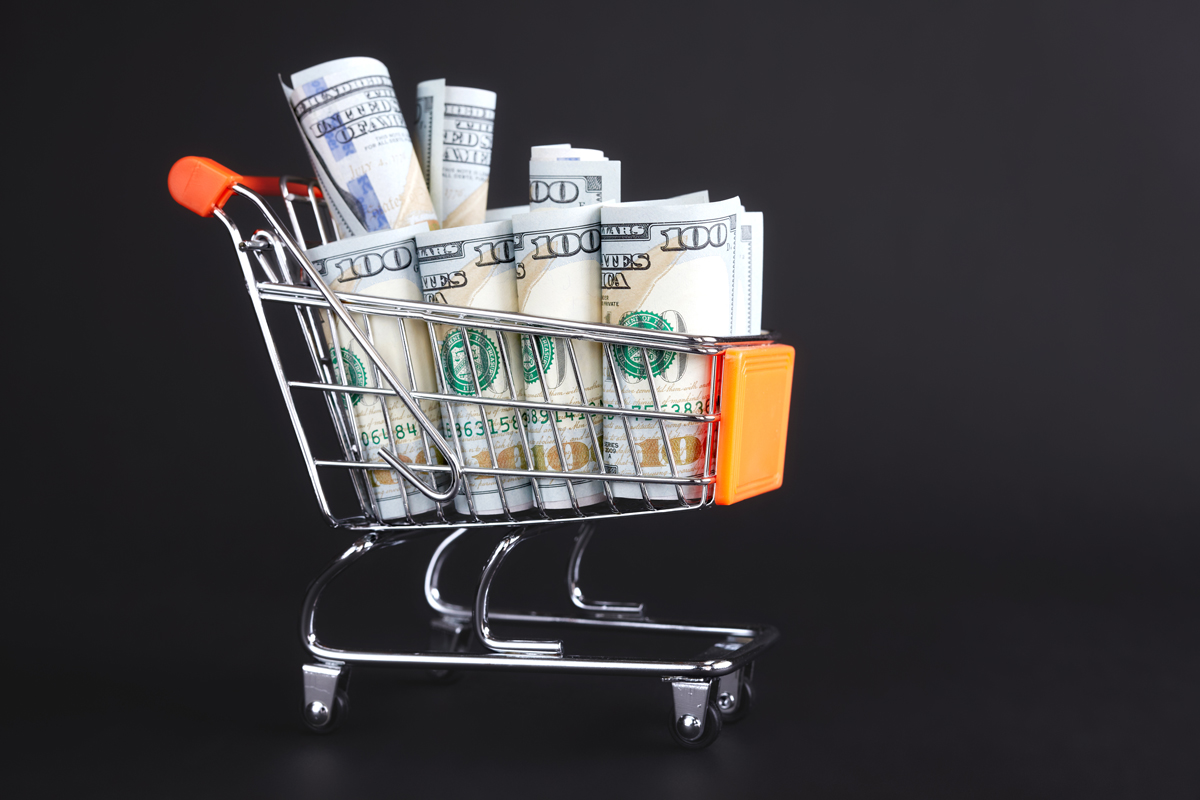
Retail Arbitrage Bottom Line
Let’s look a little further at the profitability of a product.
You should determine how much profit to expect on an item when you sell it on Amazon.
Firstly, you need to choose a fulfillment method for the product on your Amazon seller app.
On the Amazon Fulfillment row (FBA), you just need to enter your selling price, shipping expense to Amazon, and the cost of acquiring the item.
The Amazon seller app automatically derives the realizable return from investing in that item based on the data you inputted.
Now it is left to you to determine what your profit margin or your net profit should be.. It is safer to go for items that can generate more than $3 profit per item.
You also need to consider the return on investment percentage (ROI). Items that can bring about an ROI of 50% or more are recommended, particularly for new Amazon sellers.
Additionally, it is safer not to purchase too much of an item, even if it meets all the standards and criteria. The likely occurrence of pitfalls or drastic price changes should not be overlooked.
All these guidelines will help you to keep your investment risk on Amazon as low as possible.
You can simply adjust what your standard profit margins and/or ROI should be as you get more comfortable with retail arbitrage.
Starting out you really should focus on your cash flow or how often you get your money back. This is often overlooked when starting out and can kill your momentum if not planned accordingly.
Selling Fees
If you were waiting for the catch, it’s this:
Amazon takes a cut of your profits.
Selling items on Amazon comes with specific selling fees charged by Amazon.
To figure out your profit, you should consider these significant parameters:
- Selling charges
- Selling cost
- Cost of Goods
This helps to calculate your profit margins or what you stand to make after fees and costs.
Even though there are variable selling fees for different items, on average, the selling fees roughly represent a third of the selling cost of items.
For instance, if the selling cost of a product is $18, the selling fees can be about $6.
Assuming you bought the product from a neighborhood store for $6, you could profit the net gain from reselling it, which is $6 in this case. It’s a rough estimate, but it is a good rule of thumb.
Selling cost – Selling charges – Your expense = Profit
The profit calculation formula mentioned above works best for items that sell for $15 and more.
An Amazon revenue calculator makes the determination of the expected profit on any item a lot simpler and quicker. And more precise.
You may get confused, attempting to compute the net revenue on an item all by yourself. The Amazon revenue calculator is really a helpful tool for all the computations and predictions you might want to make while sourcing items to flip on Amazon.
Amazon selling fees comprise the referral fees and the variable closing fees. On average, referral fees are roughly 15% of the sales price, although it is dependent on the item category (ranging from 6% – 25%).
When I started out, I went around my home using the Amazon Seller scanning app to help me get a sense of how the fee structure works.
It really took it to home to see how to help calculate what to purchase and the price I should be looking for. It might seem pointless, but think of it like a homework assignment.
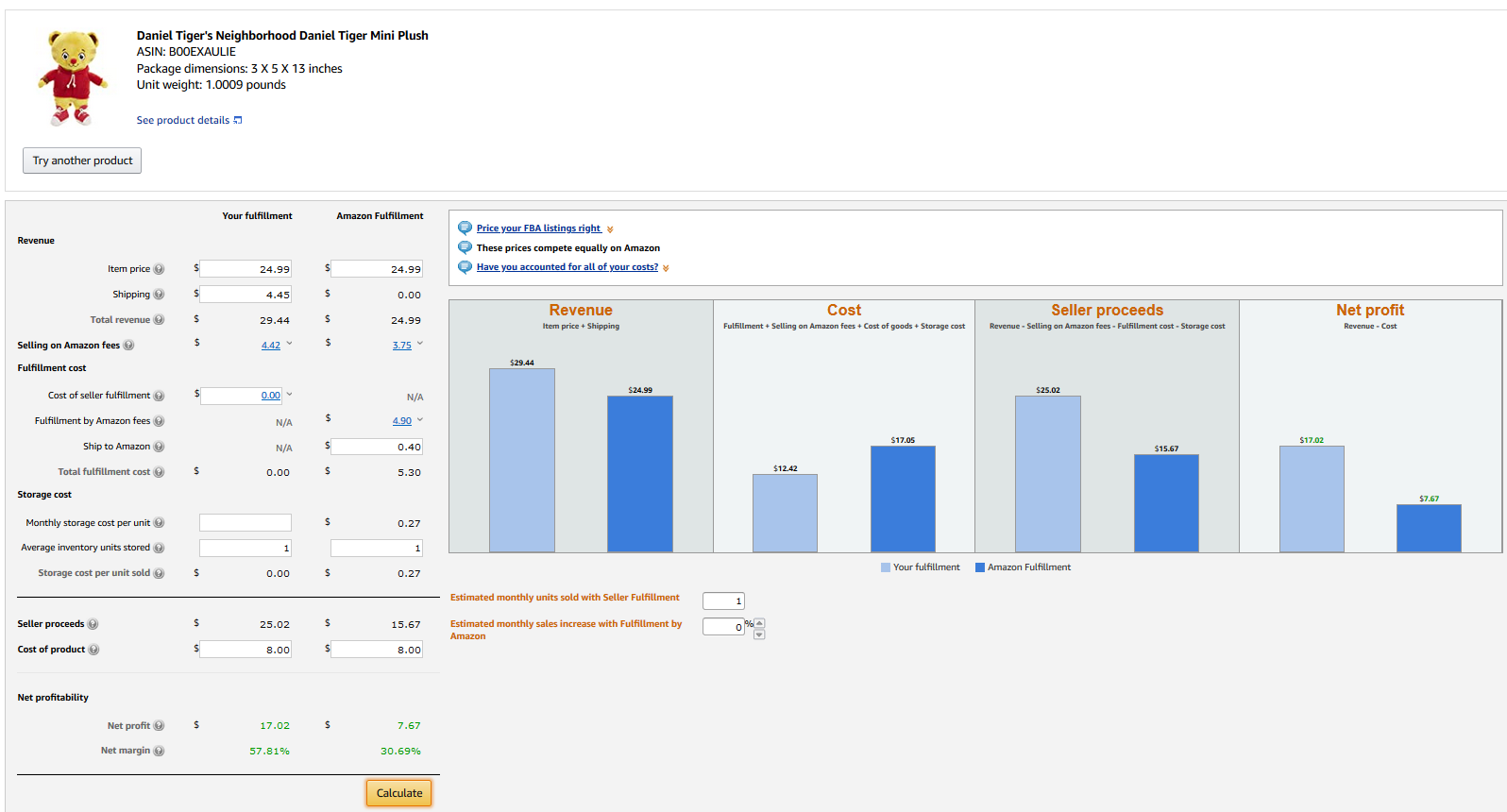
Amazon Revenue Calculator
So I mentioned a calculator in the last section. Some of you might be wondering what I’m talking about.
An Amazon revenue calculator is a useful tool that figures out the expected profit for an item.
The tool gives you a detailed insight on all of the charges that apply to sell an item on Amazon.
In a nutshell, the Amazon FBA calculator will give you an insight into the following details concerning the item you want to buy and resell on Amazon.
- Potential net profit
- FBA charges related to the item
- Determination of the maximum selling price and the lowest selling value that is gainful
- Impact of increase or decrease in sales price or item cost on the profit margin
Using the Amazon Seller App
When you get started selling on Amazon, one of the best tools you can use is the Amazon Seller App.
This is a free tool that is provided by Amazon. This tool will help you provide you with all the data and information you need to make a purchasing decision. This is different from the revenue calculator since this is an actual app you can install on your phone (it kinda does the calculations for you).
You can simply use it to scan the barcode of an item that you want to look up. The app brings up the item and you can add the costs and other fees to figure out how much profit can be made when you sell this item.
It puts the power of Amazon in your hands. It’s my favorite tool in my tool kit when it comes to retail arbitrage.
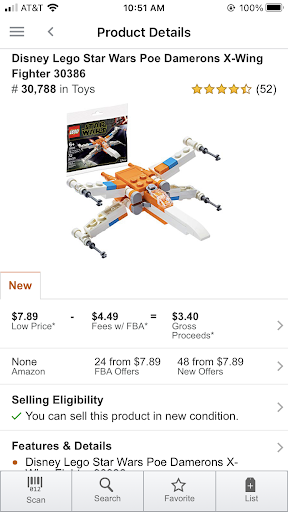
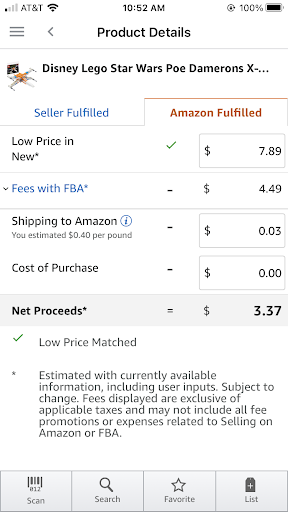
The tool will automatically show you a breakdown of your Amazon fulfillment costs (FBA expenses) including other selling charges. The Amazon seller app will calculate the expected net profit for the product.
You may even play around with the selling price or cost price of the item to know how it changes the profit margin.
It will enable you to make better choices of products while sourcing and predict the expected returns on your investment.
Some of the other information you will find in the Amazon seller app includes:
- Product Title
- Amazon Product image
- Item’s Category
- Amazon Best Seller Rank (BSR) or Sales Rank
- Number of Other Sellers
- Conditions being sold
- Price that being sold
- Does Amazon sell it?
- Reviews
If you only use one tool for retail arbitrage, this is the one you need to use.
Using the Amazon Seller App
I know we talked about this app above, but it really is integral to getting started. There are other paid apps that you might want to invest in as you move forward. However, the Amazon Seller app is perfect to get started with.
The Amazon seller app helps you to make better choices of products for retail arbitrage.
On this app, you can scan the barcode of an item using your phone camera. It will reveal the selling cost of that item on Amazon, the charges/fees, and other significant information about the item.
How to Use The Amazon Seller App
Once you have gotten the Amazon Seller app, you can start utilizing it to discover gainful products to sell on Amazon. Generally, the best items to sell on Amazon are the ones that can sell fast and with a good return on investment (ROI).
You need to use the Amazon seller app or other similar tools for scanning items you plan to purchase and resell on Amazon to know the selling price, related charges, and other useful data about that item.
After scanning the item, the Amazon seller app will bring up that particular item and a few basic details about the item.
You should tap on an arrow next to the item you have scanned (as displayed on the Amazon seller app) to give you more details about the item.
On this new page, you can determine your eligibility to sell a particular item on Amazon.
This is located under the Selling eligibility part of the page. In this section, you should have a green checkmark, which indicates that you are free to sell that item on Amazon.
The subsequent step is to check the sales rank of that item. This will show up in the upper left corner of this same page in your Amazon seller app.
What’s the Significance of the Sales Rank?
The Amazon sales rank means how fast an item is selling on Amazon when compared with other items in the same category. Aside from your profit margin, this is the second most important piece of information on the app.
The Amazon sales rank is an ideal method to gauge the pace of demand for an item. The smaller the number, the better the position or rank. This implies that the smaller the number, the quicker the item’s sell on Amazon.
But, If the item you are planning to purchase and resell doesn’t meet up with these 3 criteria above (Profit Margin, Brand Approval, and Sales Rank), then simply continue checking for other items.
Is Retail Arbitrage Even Profitable?
Well duh. You wouldn’t be reading this far if you thought this was not profitable.
There is plenty of money to be made, but you just have to know where to look. The searching is the key part of the process.
That search process starts with understanding profit and profit margins.
The Amazon seller app automatically derives the realizable return from investing in that item based on the data you inputted.
Now it is left to you to determine what your profit margin or your net profit should be. It is safer to go for items that can generate more than $3 profit per item. This gives you some wiggle room with pricing.
You also need to consider the return on investment percentage (ROI). Items that can bring about an ROI of 50% or more are recommended, particularly for new Amazon sellers.
Additionally, it is safer not to purchase too much of an item, even if it meets all the standards and criteria. One of something is great. 2,000 of something might be a little hard to move off the shelves.
Starting out you really should focus on your cash flow or how often you get your money back. This is often overlooked when starting out and can kill your momentum if not planned accordingly.
The quicker you sell your items, the quicker you can reinvest in new inventory.
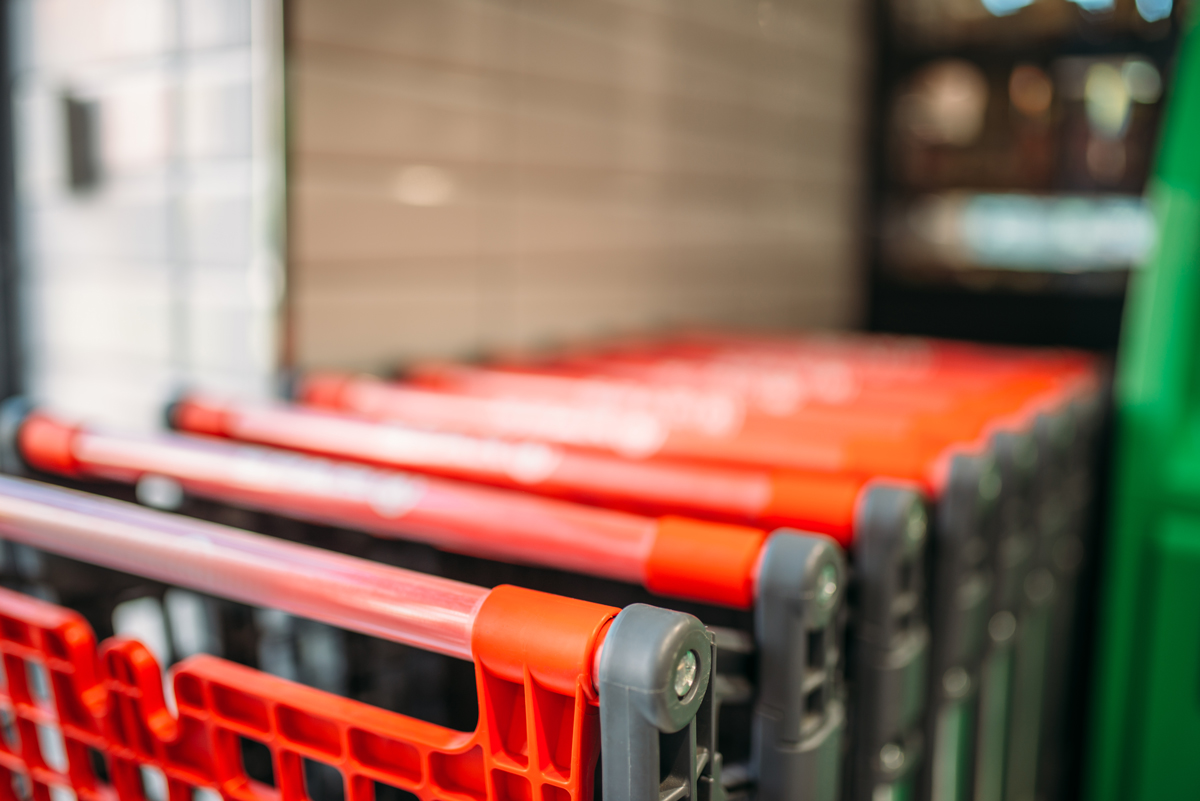
Sourcing For Products to Resell on Amazon
The guidelines discussed earlier will hopefully help you in choosing the right products that will yield a great return on your Amazon investments.
Honestly, the best way to really put things into play and take action is to just start scanning in stores. It will be hard at first, but you will learn over time what items to start scanning.
Clearance sales are a good place to start to get better prices from stores. You just need to ensure that those products from clearance deals are in perfect condition and decent quality.
Keep in mind that other sellers in different areas may have access to these same clearance items.
Don’t let that discourage you, but just be aware that there may be an influx of sellers of the same item once you send it into the Amazon warehouses.
There are numerous stores where you can go out to shop and kickstart your retail arbitrage business. Start with what is close and work out geographically from there.
Some of the stores you can buy items to flip on Amazon include:
- Walmart
- Meijer
- Kmart
- Home Depot
- Target
- Lowes
- Menards
- Walgreens
- Biglots
- CVS
- Rite Aid
- Office Depot
Pros and Cons of Amazon Retail Arbitrage
Regardless of how great and advantageous a business model can be, it will likely have a couple of inadequacies. The same goes for Amazon retail arbitrage.
Let’s consider the advantages and disadvantages of Amazon retail arbitrage.
Pros of Amazon Retail Arbitrage
Instant Checking of Products
You can check out items before purchasing them and ensure they are in perfect condition, particularly items from clearance sales. You can even know right away if you’ll make money from the items by means of selling on Amazon.
Low Cost of Entry
Retail arbitrage on Amazon gives room for sellers to start their Amazon business with about $100 to $200 as capital. My start into the world of arbitrage was with just $40 that I quickly sold and reinvested into other products.
Fast Earnings
Retail arbitrage is a simple and quick approach to bringing in cash. You don’t need to spend so much effort building a brand.
You can start making a profit in no time, even as a new seller on Amazon.
Just start selling!
Cons of Amazon Retail Arbitrage
Going to Local Stores Can be Stressful
Sometimes, It can be quite stressful and time-consuming visiting retail stores to source for products, particularly when the retail store that has the item you need to purchase is situated far away from you.
Brand Regulation
Amazon has strict rules for sellers, and there are also sanctions for erring vendors.
For example, your product listing can be flagged by Amazon when you are selling a brand restricted item without endorsement.
Amazon’s brand registry protection gives private labels or brands a specific degree of control over the listing of their products by sellers on Amazon. Only authorized sellers can list such items up for sale on Amazon.
Amazon may suspend accounts of unauthorized sellers. Amazon has strict rules and guidelines regarding the terms of use.
You need to consistently keep the Amazon rules and guidelines to evade sanctions from Amazon as some penalties can be severe at times.
Final Thoughts
Retail arbitrage represents a profitable business venture. It is quick and you can even start with a fairly low budget unlike private label or wholesale.
However, this business still requires you to work hard and smart to be a successful Amazon seller.
Since you now know how to source for profitable products to resell on Amazon and how to utilize the Amazon seller app, you should be capable of making good choices of products to buy from stores and start selling on Amazon.
A few other factors, such as product research, listing optimization, and winning the buy box, will boost your sales on Amazon.
You can even pair Tactical Arbitrage to help you find some deals that can be bought in the store if you don’t want to arbitrage online in your pjs for the day.
Regardless of how you get started, there is a ton of opportunity out there in the world of retail arbitrage.
All you have to do is get scanning and start finding products to sell on Amazon!
Related Questions
Is retail arbitrage legal on Amazon?
Yes technically it is legal as the act of reselling a product that you own is not illegal.
The Supreme court ruled in a case that reinforced the right to resell something you had lawfully purchased.
How much do you need to start retail arbitrage?
You can start to sell something from as little as a $10 investment. However, you are probably better at investing more so your expenses will go down.
Check out another article we wrote on this here.
Can I buy from Amazon and sell on Amazon?
Yes you can buy from Amazon and sell on Amazon. The only caution is you can’t use your Amazon Prime membership to do so.
It is recommended to have a business account and also utilize tax exemption.
Tactical Arbitrage even has the means to search for Amazon Flips and dedicated its own module.

